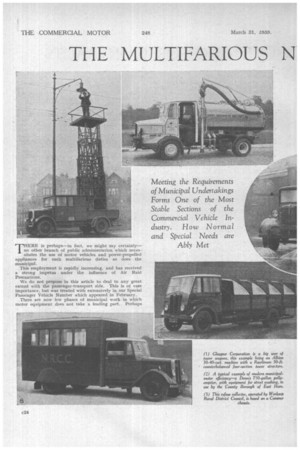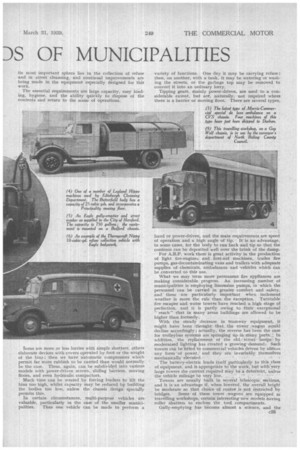THE MULTIFARIOUS N
Page 78

Page 79

Page 80

Page 81

If you've noticed an error in this article please click here to report it so we can fix it.
DS OF MUNICIPALITIES Meeting the Requirements of Municipal Undertakings Forms One of the Most Stable Sections of the Commercial Vehicle Industry. How Normal and Special Needs are
Ably Met
THERE is perhaps—in fact, we might say certainly' no other branch of public administration which necessitates the use of motor vehicles and power-propelled appliances for such multifarious duties as does the municipal.
This employment is rapidly increasing, and has received a strong impetus under the influence of Air Raid Precautions.
We do not propose in this article to deal to any great extent with the passenger-transport side. This is of vast importance. hut was treated with extensively in our Special Passenger Vehicle Number which appeared in February.
There are now few phases of municipal work in which motor equipment does not take a leading part. Perhaps its most important sphere lies in the collection of refuse and in street cleansing, and continual improvements are being made in the equipment especially designed for this work.
The essential requirements are large capacity, easy loading, hygiene, and the ability quickly to dispose ot the contents and return to the scene of operations.
Some arc more or les.s lorries with simple shutters, others elaborate devices with covers operated by foot or the weight of the bin; then we have automatic compressors which permit far more rubbish to be carried than would normally be the case. These, again, can be subdivided into various models with power-driven screws, sliding barriers, moving floors, and even hydraulic compactors.
Much time can be wasted by forcing loaders to lift the bins too high, whilst capacity may be reduced by building the bodies too low, unless the chassis design specially permits this.
In certain circumstances, multi-purpose vehicles are valuable, particularly in the case of the smaller munici palities. Thus one vehicle can be made to perform a variety of functions. One day it may be carrying refuse I then, on another, with a tank, it may be watering or washing the streets, or the garbage top may be removed to convert it into an ordinary lorry.
Tipping gears, mainly power-driven, are used to a considerable extent, but are, naturally, not required where there is a barrier or moving floor. There are several types, hand or power-driven, and the main requirements are speed of operation and a high angle of tip. • It is an advantage, in some cases, for the body to run back and tip so that the contents can be deposited well over the brink of the dump.
For A.R.P. work there is great activity in the production of light fire-engines and first-aid machines, trailer fire pumps, gas-decontaminating vans and trailers with adequate supplies of chemicals, ambulances and vehicles which can be converted to this use.
What we may term more permanent Ere appliances are making considerable progress. An increasing number of municipalities is employing limousine pumps, in which the personnel can be carried in greater comfort and safety, and: these are particularly important when inclement weather is more the rule than the exception. Turntable fire escapes.and water towers have reached a high stage of perfection, and it is partly owing to their exceptional "reach" " that in many areas buildings are allowed to be higher than formerly.
With the steady decrease in tramway equipment, it Might have been -thought, that. the tower :wagon would decline accordingly; actually, the reverse has been the case for trolleybus systems are springing hp in niany parts.; In addition, the replacement of the old.. street—lamsbymodernized lighting has created a growing. derna2nd.: Such towers can be -fitted to commercial'vehicles,driveri by alitiosi. any formof power, and they are invariably themselves
mechanically elevated. • •
The battery-electric lends itself particularly to this ,class of equipment, and is appropriate to the work, but with very large towers the current required may be a deterrent, unless the vehicle mileage be very low. • Towers are usually built in several telescopic see-Lions, and it is an advantage if, when lowered, the overall height be moderate so that choice of routes is not restricted by bridges. Some of these tower wagons. are equipped as travelling workshops, certain interesting-new models having roller shutters to enclose the tool compartments.
Gully-emptying has become almost a science, and the
vehicles employed are not only of clever design, but can also often be used as auxiliary fire pumps. Cesspools are, fortunately, declining in number, but there are still thousands in rural areas, and these demand the use of machines which frequently require a long length of piping to reach otherwise inaccessible positions ; also the work must be carried out with every attention to hygienic principles. Of course, many gully-emptiers combine this function with that of their normal use.
The inhabitants of cities and towns expect a high degree of cleanliness for their thoroughfares, and this calls for the employment of pressure-washing and mechanical sweepers, sometimes combined as a unit. Often these appliances also act as collectors, and improvements in this connection ate constantly being made so that dust is laid by water sprays, or, where dry weeping is performed, by suction apparatus.
Much use of mechanized equipment is made by highway authorities. These employ tipping lorries for road materials, rollers (which are mostly steam or oil-driven), tar sprayers (often insulated with aluminium foil, etc.), mobile concrete mixers, vehicles equipped with compressors and accommodation for pneumatic drills and the men who operate them, as well as, in some cases, travelling workshops with covered accommodation for the workers. The last named are also valuable for other classes of duty in connection with the transport systems, gas and electricity undertakings, etc.
411) Slum Clearance Calls for Special Vehicles • Slum clearance and the consequent development of large municipal housing estates have called for a variety of vehicles, including special types for disinfection, fumigation and disinfestation. Furniture from condemned buildings often has to be carried to these estates ; this requires largecapacity vans with, in some instances, equipment for freeing the furniture from parasites, whilst clothing, bed linen, etc., often have to receive special treatment, especially in cares of infectious disease,
Practically all municipalities of importance, and many of the smaller ones, have motor ambulances, many of these
vehicles being quite elaborately equipped. Some even have mobile dental clinics. Then there are what are known as children's ambulances, which are really mostly more in the nature of buses, used to convey small children and those crippled to and from school. This is a growing practice following the example of the U.S.A., where it is being adopted on a wide ed-.21e, partly because of the distances to be covered, but probably, mainly, from the safety-first aspect.
Library vans are also on the increase and constitute a very useful adjunct to the free libraries, especially in districts where the population is spread over large areas.
The police are large municipal users of motor vehicles. The old Black Marias have become neat patrol wagons, some capable of carrying 30 or more officers • in times of emergency, as distinct from the vehicle's normal use. They also should prove of value in A.R.P. work. The smaller types are mainly employed for conveying detained persons to and from the courts. Certain of the larger models, with separate cells, have safety exits by which those confined. can escape (only from the vehicles) in the event of accident or fire.
We have already referred to the electricity and gas departments, but have not mentioned that they employ quite a large number of vehicles for the conveyance of cookers, stoves, meters and general equipment, in addition to vans fOr servicing. In some of these the undoubtedly great publicity value of mobile advertising has been appreciated and accentuated by the use of particularly attractive bodywork, lettering and general finish.
For parks and playing fields, motor rollers, power-driven
mowers, vans and lorries are frequently employed. In some cases the mowers can be operated in gang fort/ration and they are transported in special vehicles.
Tractors find a use in many classes of work. Some are equipped with buffers that can be used for pushing and hauling. Smaller types can act in place of horses for mowing, rolling, etc.
Although, fortunately, we do not often have heavy falls of snow, ploughs for clearing this and the vehicles appropriate to their use must be kept in readiness, and, of course, there are parts of the country where they have to be frequently employed during the winter months.
That there is tremendous scope in the municipal sphere is indicated by the fact that one company alone claims that 600 municipal authorities make use of its power-driven products, and there are certainly others which can also lay claim to an extensive market in this connection.
• The Appeal of the Battery-electric •
We have already referred to the use of battery-electric vehicles in connection with tower wagons, but apart from this, the type is particularly appropriate for municipal service, being silent, clean, and easily handled.
In addition to their use for refuse collection, moving floors are being increasingly employed to facilitate loading and unloading. Some models have two speeds, and, of course, these are particularly applicable to refuse work. especially where barriers are utilized.
Some authorities find work for animal ambulances, and other special vehicles in connection with public abattoirs; in these the question of cleanliness is one of the most important of the problems to he studied.
One useful type of vehicle, which usually requires to be especially designed, is the cable-arum carrier. These are built so that the platform or well for the drums is particularly low, and here some form of winch is necessarily fitted, for the drums are extremely heavy.
A few words may well be said on the subject of the employment of light metals and the lighter forms of steel construction. Municipalities must study transport costs, as, for instance, in refuse collection, where there is great rivalry between different areas on the subject of cost of collection and disposal per ton. Every pound that can be saved means greater pay-load, or lower gross weight, resulting in saving on fuel, tytes and maintenance, whilst the vehicle may be brought into a lower tax category. Mechanical horses and road tractors are often employed, as is the articulated vehicle. These can be used with several trailers, so that the one power unit may be more fully engaged. Taken as a whole, the municipal field is one of the most important in the country, and the officials concerned are recognizing more and more that the increasing use of motor vehicles and appliarmes is essential.
























































































































































